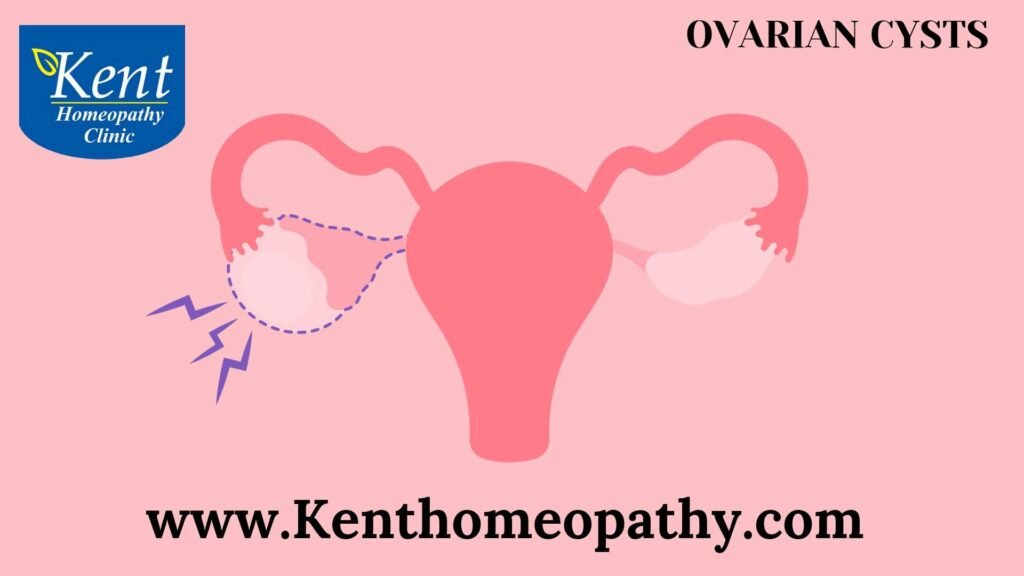Ovarian Cysts

Ovarian Cysts: Understanding Symptoms, Causes, and Types
Ovarian cysts are fluid-filled sacs that develop within or on the surface of the ovaries. While many cysts are harmless and resolve on their own, others may cause symptoms or complications. Exploring the symptoms, causes, and types of ovarian cysts is crucial for accurate diagnosis and appropriate management.
Symptoms:
- Pelvic Pain:
– Pelvic pain, ranging from a dull ache to sharp discomfort, is a common symptom of ovarian cysts. The pain may be felt on one side of the pelvis, depending on the location of the cyst.
- Bloating or Fullness:
– Ovarian cysts can cause a feeling of bloating or fullness in the abdomen. This sensation may be accompanied by a distended or swollen appearance.
- Painful Intercourse:
– Some women with ovarian cysts may experience pain during sexual intercourse, especially if the cyst puts pressure on surrounding tissues.
- Changes in Menstrual Patterns:
– Ovarian cysts can affect menstrual cycles, leading to irregular periods, heavy bleeding, or changes in the length of the menstrual cycle.
- Painful Bowel Movements:
– Large cysts may exert pressure on nearby structures, causing discomfort or pain during bowel movements.
- Frequent Urination:
– Cysts that put pressure on the bladder can result in an increased urge to urinate or a feeling of incomplete emptying.
- Nausea or Vomiting:
– Severe pain or complications from ovarian cysts may cause nausea or vomiting.
- Breast Tenderness:
– Changes in hormonal levels associated with ovarian cysts can contribute to breast tenderness.
Causes:
- Functional Ovarian Cysts:
– The most common type, functional ovarian cysts, develop as a result of the normal menstrual cycle. These cysts include follicular cysts (develop during ovulation) and corpus luteum cysts (form after the egg is released).
- Endometriomas:
– Endometriomas result from endometriosis, a condition where tissue similar to the lining of the uterus grows outside the uterus. This tissue can form cysts on the ovaries.
- Cystadenomas:
– Cystadenomas are growths that develop on the surface of the ovaries and are filled with a watery or mucous-like substance.
- Dermoid Cysts:
– Dermoid cysts are ovarian growths that can contain various types of tissues, including hair, skin, teeth, and other tissues.
- Polycystic Ovary Syndrome (PCOS):
– PCOS is a hormonal disorder that can lead to the formation of multiple small cysts on the ovaries. These cysts are often associated with irregular menstrual cycles and hormonal imbalances.
- Ovarian Tumors:
– Non-functional ovarian tumors, both benign and malignant, can present as cystic masses on the ovaries.
- Pregnancy:
– During early pregnancy, a cyst known as a corpus luteum cyst forms on the ovary. While this is a normal part of pregnancy, it can occasionally cause discomfort.
- Pelvic Infections:
– Infections affecting the pelvic region can lead to the development of cysts.
Types:
- Functional Ovarian Cysts:
– Follicular Cysts: Develop when a follicle doesn’t release an egg during the menstrual cycle.
– Corpus Luteum Cysts: Form after the release of an egg when the empty follicle doesn’t shrink as it should.
- Endometriomas:
– Endometriomas are cysts that result from endometriosis, where tissue similar to the lining of the uterus grows outside the uterus, causing cysts on the ovaries.
- Cystadenomas:
– Cystadenomas are growths on the surface of the ovaries, typically filled with a watery or mucous-like substance. They can be benign or malignant.
- Dermoid Cysts:
– Dermoid cysts are ovarian growths containing various tissues, including hair, skin, teeth, and other tissues. They are often benign.
- Polycystic Ovary Syndrome (PCOS):
– PCOS is a hormonal disorder characterized by the presence of multiple small cysts on the ovaries. These cysts are associated with irregular menstrual cycles and hormonal imbalances.
Contact to know more
Contact
Timings
Monday to Saturday:
11:00 AM to 02:30 PM
06:30 PM to 09:00 PM
